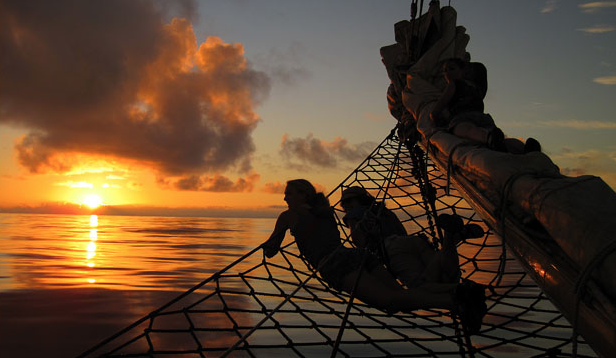
Kim McCabe is a Visitor Education Specialist at the New England Aquarium. She recently returned from an expedition in the North Pacific ocean studying plastic debris and its impact on the marine ecosystem. She'll be sharing some of her observations and reactions through the coming over the coming days.
Sometimes I find it hard to believe that a month and a half ago I was in the middle of the Pacific Ocean. I was out so far that the closest people to my ship were not in California, or in Hawaii. They were in the International Space Station over our heads! I traveled to one of the most remote ecosystems on the planet, sailed over 2500 miles, and didn’t see land for over a month. Now, the adventure is over, and I am left to reflect on our accomplishments and discoveries
 |
| Sunset in the gyre |
What we discovered was a LOT of plastic. We counted almost 70,000 pieces of plastic! I knew, before joining this expedition, that plastic was out there, but I was still astonished by the sheer quantity of plastic particles inhabiting the open ocean. It made me realize: coastlines may receive the brunt of our ecofootprint, but NO part of the planet goes unaffected.
 |
Here’s some things you can do to make a difference as consumers and citizens:
- REDUCE REDUCE REDUCE! Recycling is a great idea, but it is not a solution. It still drives consumption of petroleum, requires a lot of energy and is only an option for some kinds of plastic. Don’t use plastic unless you have to.
- BYOB: Bring your own bag! Bring your own bottle! Two million plastic bottles every five minutes is far too many. You never have to use one again.
- Avoid using single use plastics (straws, cutlery, plater, styrofoam cups, etc.). Traveling with your own coffee mug and utensils is an easy was to accomplish this.
- Shop local! Visit farmers markets and bulk aisles.
- Become an advocate: Tell your families and friends about trash in the ocean, talk to your local representatives about how to eliminate wasteful, single-use plastics.
 |
| Photo: Jon Waterman via |
Plastics in the ocean has been covered on Aquarium blogs several times, unfortunately. Learn about finding plastic debris on remote Indonesian reefs, in the open waters around Costa Rica, around islands in the Bahamas and learn how some people in Dominica are learning to reduce, reuse and recycle.



0 comments:
Post a Comment